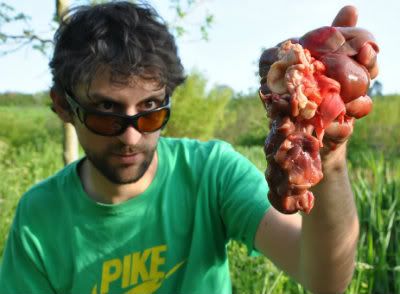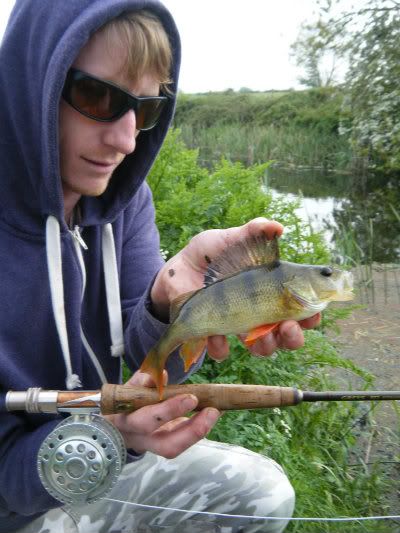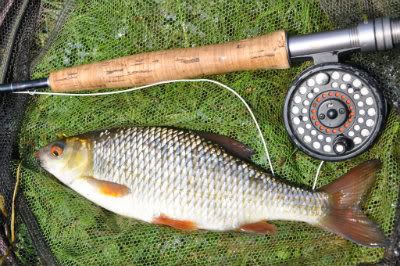
What have a size 20 dry fly and a lump of sickening offal got in common? The answer is that both have been cast in the last few days in search of fish. Another example, should any be required, that fishing is insanely varied, even in the space of one county. The offal forms the start of a new experiment in search of a reel screaming monster. I'd remembered Richard Walker's accounts of offal being dumped into pools that was devoured by carp and other scavengers- and liver, kidneys and even hearts have a history with species like catfish. Chris Lambert scored a few kilos of pure, blood drenched horror from a butcher and so this line of enquiry begins. Add white coats and clipboards and it could be a scene out of "Reanimator". So far, this is the main type of cat that has been attracted by the stench, the loveable old moggy of Town Parks fishery known as "ginge", -but watch this space to see how the trials progress:

Actually, the fishing has been fairly tricky in the heat. The end of May has seen an explosion of plant and insect life however, and so the fly rod has been put to good use. A quiet revolution continues with coarse anglers grabbing fly rods- and fresh from the butchers, Chris grabbed the fly rod to bank a first on game tackle in the shape of this canal perch, which barged through the roach to grab a pink shrimp:

We also nipped out for my Dad's birthday to seek further kicks with rising coarse fish on both small nymphs and dry flies. The fish are already gathering prior to spawning and not entirely focussed on eating- although sport was reasonable.

Perhaps the best fun of all was taking roach off the surface at Westleigh, with takes falling to either a size 18-20 F Fly or a ginked up spider presented in the surface film.

A few Sunday boats then coloured the water- and sight fishing got harder thereon in. Do you need to see the fish and takes to catch roach on the fly? Not necessarily- you can watch for rise forms or use an indicator. But in truth, it's a bloody big help to spot your fish, as is having flies that show up well, whether that means a black fly for light backdrops, or a light tan, pink or hares ear coloured fly to stand out against darker backgrounds. Goldheads have also been surprisingly decent for roach and rudd- albeit only in pretty small sizes (16-18). And that's fly fishing- whatever the species, a little change can be the difference between fish and frustration. Good luck to everyone casting a fly this summer- lots of absorbing sport to look forward to.
 What have a size 20 dry fly and a lump of sickening offal got in common? The answer is that both have been cast in the last few days in search of fish. Another example, should any be required, that fishing is insanely varied, even in the space of one county. The offal forms the start of a new experiment in search of a reel screaming monster. I'd remembered Richard Walker's accounts of offal being dumped into pools that was devoured by carp and other scavengers- and liver, kidneys and even hearts have a history with species like catfish. Chris Lambert scored a few kilos of pure, blood drenched horror from a butcher and so this line of enquiry begins. Add white coats and clipboards and it could be a scene out of "Reanimator". So far, this is the main type of cat that has been attracted by the stench, the loveable old moggy of Town Parks fishery known as "ginge", -but watch this space to see how the trials progress:
What have a size 20 dry fly and a lump of sickening offal got in common? The answer is that both have been cast in the last few days in search of fish. Another example, should any be required, that fishing is insanely varied, even in the space of one county. The offal forms the start of a new experiment in search of a reel screaming monster. I'd remembered Richard Walker's accounts of offal being dumped into pools that was devoured by carp and other scavengers- and liver, kidneys and even hearts have a history with species like catfish. Chris Lambert scored a few kilos of pure, blood drenched horror from a butcher and so this line of enquiry begins. Add white coats and clipboards and it could be a scene out of "Reanimator". So far, this is the main type of cat that has been attracted by the stench, the loveable old moggy of Town Parks fishery known as "ginge", -but watch this space to see how the trials progress:
 Actually, the fishing has been fairly tricky in the heat. The end of May has seen an explosion of plant and insect life however, and so the fly rod has been put to good use. A quiet revolution continues with coarse anglers grabbing fly rods- and fresh from the butchers, Chris grabbed the fly rod to bank a first on game tackle in the shape of this canal perch, which barged through the roach to grab a pink shrimp:
Actually, the fishing has been fairly tricky in the heat. The end of May has seen an explosion of plant and insect life however, and so the fly rod has been put to good use. A quiet revolution continues with coarse anglers grabbing fly rods- and fresh from the butchers, Chris grabbed the fly rod to bank a first on game tackle in the shape of this canal perch, which barged through the roach to grab a pink shrimp:
 We also nipped out for my Dad's birthday to seek further kicks with rising coarse fish on both small nymphs and dry flies. The fish are already gathering prior to spawning and not entirely focussed on eating- although sport was reasonable.
We also nipped out for my Dad's birthday to seek further kicks with rising coarse fish on both small nymphs and dry flies. The fish are already gathering prior to spawning and not entirely focussed on eating- although sport was reasonable.
 Perhaps the best fun of all was taking roach off the surface at Westleigh, with takes falling to either a size 18-20 F Fly or a ginked up spider presented in the surface film.
Perhaps the best fun of all was taking roach off the surface at Westleigh, with takes falling to either a size 18-20 F Fly or a ginked up spider presented in the surface film.
 A few Sunday boats then coloured the water- and sight fishing got harder thereon in. Do you need to see the fish and takes to catch roach on the fly? Not necessarily- you can watch for rise forms or use an indicator. But in truth, it's a bloody big help to spot your fish, as is having flies that show up well, whether that means a black fly for light backdrops, or a light tan, pink or hares ear coloured fly to stand out against darker backgrounds. Goldheads have also been surprisingly decent for roach and rudd- albeit only in pretty small sizes (16-18). And that's fly fishing- whatever the species, a little change can be the difference between fish and frustration. Good luck to everyone casting a fly this summer- lots of absorbing sport to look forward to.
A few Sunday boats then coloured the water- and sight fishing got harder thereon in. Do you need to see the fish and takes to catch roach on the fly? Not necessarily- you can watch for rise forms or use an indicator. But in truth, it's a bloody big help to spot your fish, as is having flies that show up well, whether that means a black fly for light backdrops, or a light tan, pink or hares ear coloured fly to stand out against darker backgrounds. Goldheads have also been surprisingly decent for roach and rudd- albeit only in pretty small sizes (16-18). And that's fly fishing- whatever the species, a little change can be the difference between fish and frustration. Good luck to everyone casting a fly this summer- lots of absorbing sport to look forward to.


2 comments:
Caught my first fly caught fish, a rudd, the other day, I had a try after reading your book . Great stuff !
I will be using the fly a lot more often this year.
Excellent work Marc- and thanks for buying the book. No doubt more fish to follow now you're off the mark- I always think the first is the hardest on any new method. Enjoy!
Post a Comment